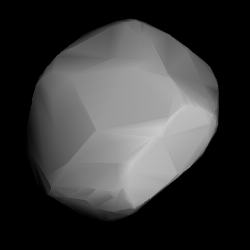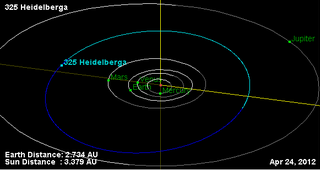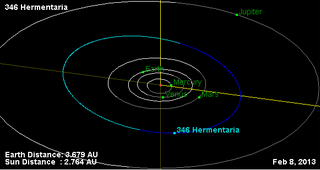
2685 Masursky, provisional designation 1981 JN, is a stony Eunomian asteroid from the central regions of the asteroid belt, approximately 11 kilometers in diameter. It was discovered on 3 May 1981, by American astronomer Edward Bowell at the Anderson Mesa Station near Flagstaff, Arizona, and named after American planetary geologist Harold Masursky. In January 2000, the Cassini space probe observed the S-type asteroid from afar during its coast to Saturn.

110 Lydia is a large belt asteroid with an M-type spectrum, and thus may be metallic in composition, consisting primarily of nickel-iron. It was discovered by French astronomer Alphonse Borrelly on 19 April 1870 and was named for Lydia, the Asia Minor country populated by Phrygians. The Lydia family of asteroids is named after it.

114 Kassandra is a large and dark main-belt asteroid. It belongs to the rare class T. It was discovered by C. H. F. Peters on July 23, 1871, and is named after Cassandra, the prophetess in the tales of the Trojan War.

127 Johanna is a large, dark main-belt asteroid that was discovered by French astronomers Paul Henry and Prosper Henry on 5 November 1872, and is believed to be named after Joan of Arc. It is classified as a CX-type asteroid, indicating the spectrum shows properties of both a carbonaceous C-type asteroid and a metallic X-type asteroid.

135 Hertha is an asteroid from the inner region of the asteroid belt, approximately 77 kilometers in diameter. Discovered on 18 February 1874 by German–American astronomer Christian Peters at the Litchfield Observatory near Clinton, New York, it was named after the Teutonic and Scandinavian goddess of fertility, Hertha, also known as Nerthus. It orbits among the Nysa asteroid family, but its classification as a metallic M-type asteroid does not match the more common F-type asteroid for this family, suggesting that it may be an interloper. Spectroscopic analysis indicates the possible presence of hydrated silicates indicating that Hertha should possibly be reclassified from its present M-type to the proposed W-type.

140 Siwa is a large and dark main-belt asteroid that was discovered by Austrian astronomer Johann Palisa on October 13, 1874, and named after Živa (Šiwa), a Slavic goddess of fertility.

194 Prokne is a main-belt asteroid that was discovered by German-American astronomer C. H. F. Peters on March 21, 1879, in Clinton, New York, and named after Procne, the sister of Philomela in Greek mythology. Stellar occultations by Prokne have been observed twice, in 1984 from Italy and again in 1999 from Iowa.

3554 Amun is an Aten asteroid, meaning it crosses Earth's orbit, and a Venus-crosser. It was discovered on 4 March 1986 by Carolyn and Eugene Shoemaker at Mount Palomar Observatory, and named for the ancient Egyptian deity Amun. Amun was the fifth Aten asteroid to be numbered.

201 Penelope is a large main belt asteroid that was discovered by Austrian astronomer Johann Palisa on August 7, 1879, in Pola. The asteroid is named after Penelope, the wife of Odysseus in Homer's The Odyssey. It is orbiting the Sun at a distance of 2.68 AU with an eccentricity (ovalness) of 0.18 and a period of 4.381 years. The orbital plane is tilted at an angle of 5.8° to the plane of the ecliptic.

238 Hypatia is a large main-belt asteroid that was discovered by Russian astronomer Viktor Knorre on July 1, 1884, in Berlin. It was the third of his four asteroid discoveries. The name was given in honour of philosopher Hypatia of Alexandria. Based upon the spectrum, it is classified as a C-type asteroid and is probably composed of primitive carbonaceous material. Like many asteroids of this type, its surface is very dark in colour.

325 Heidelberga is a large main belt asteroid that was discovered by German astronomer Max Wolf on 4 March 1892 in Heidelberg. It is orbiting the Sun at a distance of 3.21 AU with an eccentricity of 0.159. The orbital plane is inclined at an angle of 8.55° to the ecliptic.

346 Hermentaria is a very large main-belt asteroid. It was discovered by French astronomer Auguste Charlois on 25 November 1892, in Nice. It is probably named for the town of Herment in the region of Auvergne, France. The asteroid is orbiting the Sun with a period of 4.68 years and an eccentricity (ovalness) of 0.10. The orbital plane is inclined by 8.7° to the plane of the ecliptic.

397 Vienna is a typical Main belt asteroid. It was discovered by French astronomer Auguste Charlois on 19 December 1894 in Nice, and was most likely named after the city of Vienna, Austria. This object is orbiting the Sun at a distance of 2.64 AU with an orbital eccentricity (ovalness) of 0.246 and a period of 4.28 yr. The orbital plane is inclined at an angle of 12.85° to the ecliptic.
478 Tergeste is a rare-type stony asteroid from the outer region of the asteroid belt, approximately 78 kilometers in diameter. It was discovered on 21 September 1901, by Italian astronomer Luigi Carnera at Heidelberg Observatory in southern Germany. It was named after the Italian city of Trieste.
785 Zwetana is a minor planet orbiting the Sun that was discovered by Adam Massinger, an assistant at the Heidelberg Observatory, on March 30, 1914. It was named for the daughter of Kiril Popoff, a Bulgarian astronomer. This asteroid is orbiting 2.57 AU from the Sun with an eccentricity (ovalness) of 0.21 and a period of 4.12 yr. The orbital plane is inclined by an angle of 12.8° to the plane of the ecliptic.

867 Kovacia is an elongated, dark asteroid and member of the Hygiea family from the outer regions of the asteroid belt. It was discovered on 25 February 1917, by astronomer Johann Palisa at the Vienna Observatory in Austria. The carbonaceous C/B-type asteroid has a rotation period of 8.7 hours and measures approximately 24 kilometers in diameter. It was named after Austrian physician Friedrich Kovacs (1861–1931).
1280 Baillauda, provisional designation 1933 QB, is a dark background asteroid from the outermost region of the asteroid belt, approximately 52 kilometers in diameter. Discovered by Eugène Delporte at Uccle Observatory in 1933, the asteroid was named after French astronomer Jules Baillaud.
2246 Bowell, provisional designation 1979 XH, is a rare-type Hildian asteroid from the outermost region of the asteroid belt, approximately 44 kilometers in diameter. It was discovered on 14 December 1979, by American astronomer Edward Bowell at Lowell Observatory's Anderson Mesa Station, and named after the discoverer himself.
9344 Klopstock, provisional designation 1991 RB4, is a background asteroid from the inner regions of the asteroid belt. It was discovered on 12 September 1991, by German astronomers Freimut Börngen and Lutz Schmadel at the Karl Schwarzschild Observatory in Tautenburg, Germany. Poor observational data suggests that the asteroid is one of the darkest known objects with a diameter of approximately 17 kilometers (11 miles), while it is also an assumed stony asteroid with a much smaller diameter. It has a rotation period of 5.84 hours and was named after German poet Friedrich Gottlieb Klopstock.
1392 Pierre, provisional designation 1936 FO, is a dark, dynamical Eunomian asteroid from the central regions of the asteroid belt, approximately 26 kilometers (16 mi) in diameter. It was discovered on 16 March 1936, by astronomer Louis Boyer at the Algiers Observatory in Algeria, North Africa. The asteroid was named after the discoverer's nephew, Pierre.













